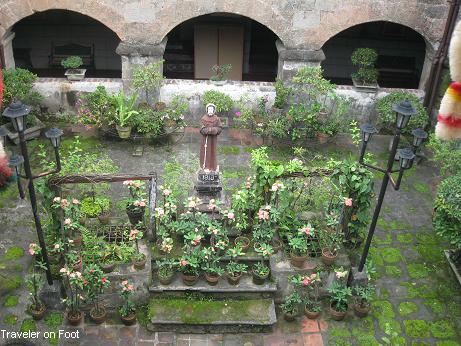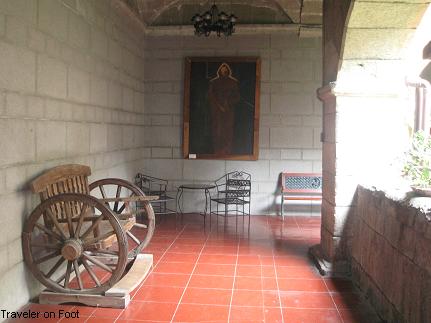Once upon a time, there was an Intramuros (inside the wall) and an Extramuros (outside the wall). Before the British invasion, Extramuros was a series of settlements on the banks of the moat that surrounded the walls of Intramuros.

For Nick Joaquin, the swath of open country (and potential parkland) that appeared when Extramuros villages were cleared away is the best legacy of the British Occupation. On these grounds we now see Rizal Park, Burgos Drive, the Mehan Garden and Liwasang Bonifacio.
The Villages of Extramuros
There were at least six of these original suburbs. They were known as the Bagumbayan, Santiago, San Juan, San Fernando de Dilao, San Miguel and the Parian.
Bagumbayan and Santiago were on the bayside, approximately where the Old Luneta is. Bagumbayan or New Town was the first to be established. It was built after Legaspi occupied the island of Maynilad, burned and abandoned by Soliman’s folk, who fled across the river to Tondo. Those who later returned were mostly of the native nobility and , their old kingdom of Maynilad being now in the hands of the Spanish, they decided to settle on the bayside south of the old kingdom.
Adjoining Bagumbayan on the seaside was the village of Santiago, which apparently began as a Spanish settlement, for those of the whites who didn’t care to live inside the walls. They had a church of their owned administered by a secular, with St. James the Apostle as patron.

San Juan was where the western part of Rizal Park is, up to the old Legislative Building. This village must have been a fine location say Nick Joaquin, for there in the 1600s, Governor Perdo de Acuna built himself a summer house, with gardens and ponds, only three hundred paces from the walls. When the governor died, the newly arrived Recollects bought the property and there established their first convent and school.
In the convent rest the three incorrupt bodies of the first founders, so well preserved in the country so damp and hot it is regarded as a miracle. Moreover, the college possessed a great treasure in the image of Our Lady of Health.
San Fernando de Dilao occupied the present site of the Manila City Hall and the Normal Colleges. This village was where some Japanese Christians lived, under the care of the Franciscan friars. It was in the Dilao where the friars ran a hospital for lepers, the original San Lazaro Hospital and a mission house under the advocacy of Our Lady of Candlemas.
The site assumed to have been called Dilao (yellow) because it was the Japanese ghetto but the name may actually refer to a plant there that yeilded yellow dye. The titular patron of the parish church was St. Ferdinand the King but popular devotion prompted pilgrimages to La Candelaria.

San Miguel stood in the San Marcelino area, where Adamson University stands. According to Joaquin, the original parish of San Miguel was established in 1618, as another mission for the Japanese, but under the Jesuit auspices. Japanese refugees fleeing fromt he tyrant Taycosama were gravitating to Manila, to the Japanese enclave on the left bank of the Pasig.
Since many of the refugees were samurai, or warriors, the Jesuits hit on the idea of proclaiming a soldier saint as the patron of the growing Japanese community, to attract the knight among the migrants. And what a heavenly soldier was more glorious the St. Michael the Archangel?

The Chinese Parian was on the banks of the Pasig where later would rise the Post Office, Liwasang Bonifacio, the Metropolitan Theater and Mehan Garden. It was the largest of the original suburbs, where the Sangleys had their silk market, porcelain factories, tool shops and other hardware stores, as well as eating houses where the Filipinos first developed a taste for comida China. The panciteria began in the Parian.

By the 18th century, Manila extramuros had become teeming crescent confronting Intramuros with a jumble of roofs, towers, massive stone churches and crowded streets.

An alarmed Spanish military complained that their guns on the city walls would be thwarted by this barricade of extramuros roof in case of an enemy invasion.
The Invasion that Cleared Away Extramuros
War broke out between Spain and England in 1762. A British fleet sped east to capture Manila. The invading squadron of 13 ships was under Admiral Samuel Cornish.
The British invasion proved how right the fears of the Spanish military were. When the British landed on the beach of Malate, they advanced towards the Walled City under the cover of the suburbs. They fortified the churches there and mounted cannons on them to bombard Intramuros. Intramuros was being shelled from Extramuros!
After the British invasion, the army’s demand that the extramuros suburbs be removed could never be denied, although the Church succeeded in preventing the demolition of Malate, Ermita and Binondo. They were cleared away not only because they had proved how dangerous they were but because for a long time after 1764 Manila continued to fear another British invasion.

The parish of Dilao was moved south to the banks of Estero Paco. The parish of San Miguel was transferred across the river to the marshy island called Malacañang.

The rest of Manila extramuros –Bagumbayan, Santiago, San Juan and the Parian were completely exterminated.
That’s the lost Manila we never knew.
Information source: Manila , My Manila by Nick Joaquin











